
Johannes van Dreght (11 November 1737, Amsterdam - 7 October 1807, Amsterdam) was a Dutch decorative painter; known for his work on fireplaces, carriages, yachts, sleds and fans.

Johannes van Dreght (11 November 1737, Amsterdam - 7 October 1807, Amsterdam) was a Dutch decorative painter; known for his work on fireplaces, carriages, yachts, sleds and fans.
He became a member of the local Guild of Saint Luke in 1758. He married in 1761 and was elected to the Stadstekenacademie, Amsterdam, in 1766 and received an honorary prize from the Drawing Academy. He maintained his home and studio on Kerkstraat , near the Amstel. Politically, he was a supporter of the Patriottentijd; a group that admired the ancient Roman Republic
In 1772, he created a chimney piece (Schoorsteenstuk ) for the Town Hall, as well as works for the original Dutch Theater (1774), the buildings at 518 and 520 Herengracht and in the Corvershof, a home belonging to the son of Mayor Joan Corver (1778). In 1781, and again in 1792, he provided the sets and scenery for productions of The Barber of Seville , by Beaumarchais. Much of his work represents a transition to Neoclassicism.
The wallpaper designer, Jurriaen Andriessen, is one of his best known students. The poet, Willem Bilderdijk, learned some etching and drawing techniques from him.
![]() Media related to Johannes van Dreght at Wikimedia Commons
Media related to Johannes van Dreght at Wikimedia Commons

Willem Bilderdijk was a Dutch poet, historian, lawyer and linguist.

Nicolaes Pieterszoon Berchem was a highly esteemed and prolific Dutch Golden Age painter of pastoral landscapes, populated with mythological or biblical figures, but also of a number of allegories and genre pieces.

The Hague School is a group of artists who lived and worked in The Hague between 1860 and 1890. Their work was heavily influenced by the realist painters of the French Barbizon school. The painters of the Hague school generally made use of relatively somber colors, which is why the Hague School is sometimes called the Gray School.

Pieter Cramer, was a wealthy Dutch merchant in linen and Spanish wool, remembered as an entomologist. Cramer was the director of the Zealand Society, a scientific society located in Flushing, and a member of Concordia et Libertate, based in Amsterdam. This literary and patriotic society, where Cramer gave lectures on minerals, commissioned and/or financed the publishing of his book De uitlandsche Kapellen, on foreign (exotic) butterflies, occurring in three parts of the world Asia, Africa and America.
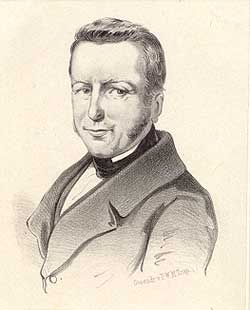
Isaäc da Costa was a Jewish poet.

Willem Theodoor "Wim T." Schippers is a Dutch artist, comedian, television director, and voice actor. During the 1960s, he worked mostly as a visual artist, associated with the international Fluxus-movement. As a television writer, director, and actor he is responsible for some of the most notable and controversial shows on Dutch televisions from the 1960s to the 1990s, creating a number of lasting characters and enriching the language with terms and expressions first coined in his shows. In addition, he voiced the characters of Ernie and Kermit the Frog on the Dutch version of Sesame Street. For his shows, he has written over three hundred songs, and his reputation has changed from being Dutch television's "enfant terrible" to an acknowledged master in a variety of genres.

Nicolaes Witsen was a Dutch statesman who was mayor of Amsterdam thirteen times, between 1682 and 1706. In 1693 he became administrator of the Dutch East India Company (VOC). In 1689 he was extraordinary-ambassador to the English court and became Fellow of the Royal Society. In his free time, he was cartographer, maritime writer, and an authority on shipbuilding. His books on the subject are important sources on Dutch shipbuilding in the 17th century. Furthermore, he was an expert on Russian affairs. He was the first to describe Siberia, the Far East and Central Asia in his study Noord en Oost Tartarye [North and East Tartary].

Rombout Verhulst was a Flemish sculptor and draughtsman who spent most of his career in the Dutch Republic. There he helped introduce the Baroque style in sculpture while becoming the leading sculptor of marble monuments, including funerary monuments, garden figures and portraits.

Willem de Clercq was a poet and leader of the Réveil, the Protestant Church Revival in the Netherlands. He is known for his diary entries, which contain extensive reports of the events he witnessed. He was also a secretary (1824-1831) and later a director (1831–1844) of the Netherlands Trading Society.

The Revd Dr Abraham Capadose or Capadoce was a Dutch physician and Calvinist writer. A Jewish convert to Christianity from 1822 onwards, he was part of the Dutch Réveil circle that also included da Costa and Willem de Clercq.
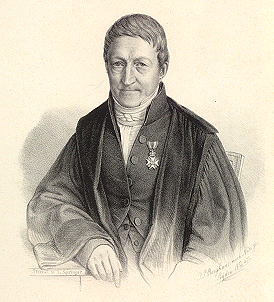
Matthijs Siegenbeek was a Dutch academic. From 1797 to 1847 he was the first professor of the Dutch language at the University of Leiden. From 1803 he was the member, then secretary, of the head-office of that university's literary faculty. Initially he was a Mennonite voorganger in Dokkum.
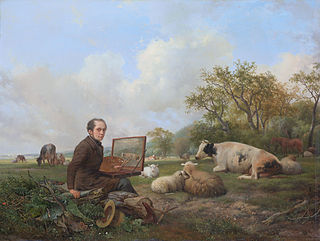
Hendrik (Hendrikus) van de Sande Bakhuyzen was a Dutch landscape painter and art teacher. He was a prominent contributor to the Romantic period in Dutch art and his students and children founded the art movement known as the Hague School. Like his contemporaries Edward Williams, Jacob Maris, and Jozef Israëls, he was part of a family of prominent painters, including son Julius van de Sande Bakhuyzen, daughter Gerardina Jacoba van de Sande Bakhuyzen, and nephew Alexander Hieronymus Bakhuyzen.

Pulchri Studio is a Dutch art society, art institution and art studio based in The Hague ('s-Gravenhage), Netherlands.
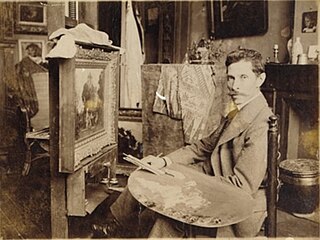
Johannes Evert Hendrik Akkeringa was part of the second generation of the Hague School painters. Akkeringa is primarily known for his paintings and watercolours of women and playing children at the beach, women mending nets and intimate tea-time conversations.

Johannes de Bosch (1713–1785) was a Dutch painter, engraver and draughtsman. De Bosch was born in Amsterdam, the son of the apothecary Jeroen de Bosch, who owned a significant collection of paintings and drawings, he was surrounded and influenced by fine art from an early age.
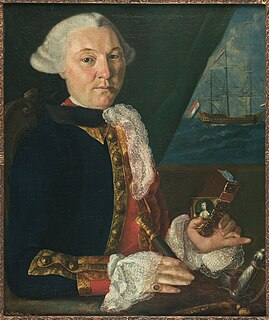
Jacobus Deketh was a captain in the Frisian Admiralty, one of the five admiralties of the Dutch Republic. In 1744 at the age of 18, Deketh joined the Admiralty of Amsterdam. He became a lieutenant and later extraordinary captain and sailed to the Dutch East Indies. In 1758, Deketh continued his career in the Frisian Admiralty. He became captain of a ship, Edam. He was appointed full captain of the Frisian Admiralty in 1760.
Axel Erik van der Kraan is a Dutch sculptor, performance artist and graphic artist, also known with Helena van der Kraan as Axel and Helena van der Kraan.
The Laren School is the name of an art colony located in the Dutch village, Laren, in the Gooi near Hilversum. The artists of this offshoot of the Hague School chose the inhabitants of Laren and the surrounding landscape as the subject of their art.
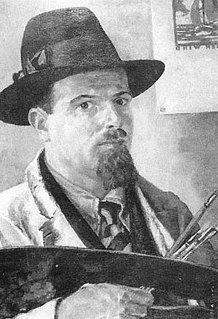
Leonard "Leo" Jehoeda Pinkhof (1898-1943) was a Dutch painter.